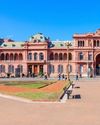Art, architecture and design form the basis of Bilbao’s attraction.

Bilbao doesn’t fit the usual tourist images of Spain: flamenco dancers, hilltop castles, Moorish palaces. In fact, until 20 years ago, this gritty industrial port on Spain’s north coast was hardly known to tourists at all.
Now more than a million visit each year, and the city’s name is synonymous with the travel trend it created — architourism. As if that were not enough, the city also gave its name to an economic phenomenon known as the Bilbao Effect.
How did Bilbao transform itself from an ugly, run-down industrial wasteland to a glittering city where tourists come just to stand and marvel at its buildings and bridges? It’s a story of foresight and vision, and one that elevates risk-taking to a fine art.
The ambitious redevelopment program began in the late 1980s with a new airport and a stunning footbridge, both designed by acclaimed architect Santiago Calatrava. Then a performance and convention center, the Palacio Euskalduna, was erected on the riverside site of the former shipyard. Following discussions with the Guggenheim Foundation, work started in 1993 on Frank O. Gehry’s design for a building that would knock the socks off the architectural world. The reaction to the opening of Guggenheim Museum Bilbao in 1997 surpassed the city’s wildest dreams; within only three years, revenue generated by Gehry’s masterpiece more than exceeded its cost.
Bu hikaye Global Traveler dergisinin July 2016 sayısından alınmıştır.
Start your 7-day Magzter GOLD free trial to access thousands of curated premium stories, and 9,000+ magazines and newspapers.
Already a subscriber ? Giriş Yap
Bu hikaye Global Traveler dergisinin July 2016 sayısından alınmıştır.
Start your 7-day Magzter GOLD free trial to access thousands of curated premium stories, and 9,000+ magazines and newspapers.
Already a subscriber? Giriş Yap

Nurturing Nature
Connect with the abundant flora and fauna of Belize.

Sojourn by the Sea
Discover plenty to smile about in Thailand’s exotic islands.

Colorado Dreaming
For family ski fun, Snowmass and Beaver Creek steal the show.

The Great Outdoors
Anchorage opens the door to all that is wild in Alaska.

Buenos Aires on Foot
Hit the highlights with online itineraries and the city’s free app.

Above and Beyond
Global Traveler celebrates the 2021 winners of the GT Tested Reader Survey awards.

Wellness Wonderland
Reboot at Lake Austin Spa Resort in Texas Hill Country.

Good Vibes
Adelaide’s West End thrives as a hip urban hub close to nature.

Solo Voyages
Cruise lines adapt policies to accommodate those traveling alone.

Grand Slam
Follow the pro tennis tour around the world.